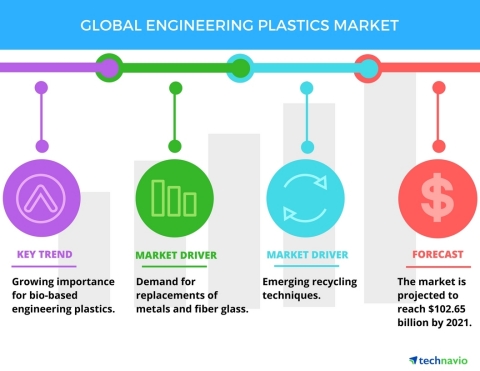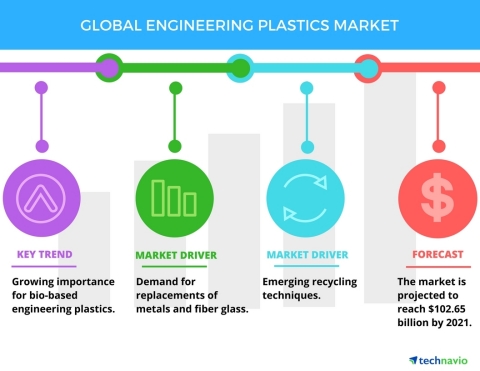LONDON--(BUSINESS WIRE)--Technavio market research analysts forecast the global engineering plastics market to grow at a CAGR of more than 7% during the forecast period, according to their latest report.
The market study covers the present scenario and growth prospects of the global engineering plastics market for 2017-2021. The report also lists ABS, PA, Fluoropolymer, and PC as the four major segments based on type. In terms of geography, the demand is primarily driven by APAC. This can be attributed to the growing demand for engineering plastic from the automobile and electrical and electronics sectors in this region.
This report is available at a USD 1,000 discount for a limited time only: View market snapshot before purchasing
Buy 1 Technavio report and get the second for 50% off. Buy 2 Technavio reports and get the third for free.
Technavio analysts highlight the following three market drivers that are contributing to the growth of the global engineering plastics market:
- Demand for replacements of metals and fiber glass
- Growing recycling techniques
- Increasing demand from automobile industry
Looking for more information on this market? Request a free sample report
Technavio’s sample reports are free of charge and contain multiple sections of the report including the market size and forecast, drivers, challenges, trends, and more.
Demand for replacements of metals and fiber glass
The use of metals or thermosets is replaced by engineering plastics in the electrical and electronics, and automobile industries. This can be attributed to the reduction in manufacturing cost, time, and high tensile strength, which is enabled by engineering plastics. It is estimated that the cost can be reduced up to 50% by replacing metals with engineering plastics. Also, engineering plastics help in achieving thinner-walled designs, which can easily replace thicker die-casted metal parts.
According to Kshama Upadhyay, a lead analyst at Technavio for plastics, polymers, and elastomers research, “The manufacturing process of fiber glass is costly and labor intensive, and, emits higher volatile organic compounds than engineering plastics. Stringent regulations established by several government agencies are challenging the manufacture of fiber glass, which is boosting the global engineering plastics market.”
Growing recycling techniques
Plastics are non-degradable substances, which can drastically impact the ecological balance. Plastics take more than 50 years to degrade, which leads to incineration or landfills. To overcome this, gasification, solvolysis, pyrolysis, and thermolysis treatments play a crucial role to provide better recycling and reuse processes. In the UK alone, approximately 2.1 million tons of electrical and electronic equipment waste and 1.7 million vehicles are discarded every year. Therefore, the European government has set a target of recycling approximately 57% of plastic packaging by 2021.
“Closed loop projects, such as EURECOMP, facilitate the recycling of plastics through solvolysis process. This process helps in separating the components such as fillers, fibers, and matrix compounds. This process aids in preserving the length of the recovered fibers, which can be re-used in technical industries such as electrical and electronic industries. Therefore, innovative recycling technologies for engineering plastics will boost the global engineering plastics market,” says Kshama.
Increasing demand from automobile industry
The demand for engineering plastics from the automotive industry is growing every year. This can be attributed to the need for lightweight vehicles, which emit lesser CO2. It is expected that the global emission of CO2 will reach 39.3 billion metric tons by 2030. At the same time, the global automobile production will also grow at approximately 3% during the forecast period.
To curb such a burgeoning problem, governments have established stringent regulations to reduce the CO2 emissions from the automotive segment. For instance, the EPA and the National Highway Traffic Safety Administration (NHTSA) have imposed regulations such as 40 Council on Foreign Relations (CFR) Part 85 on greenhouse emissions by light-duty vehicles. Such regulations are expected to reduce 6 billion metric tons of greenhouse gases (GHG) from 2012 to 2020. This is driving the automobile manufacturers to reduce the weight of vehicles, subsequently resulting in increased use of engineering plastics in automobiles.
Browse Related Reports:
- Global Plastic Additives Market 2017-2021
- Global Polyurethane Foam Blowing Agents Market 2017-2021
- Global Thermoplastic Polyolefins Market 2017-2021
About Technavio
Technavio is a leading global technology research and advisory company. Their research and analysis focuses on emerging market trends and provides actionable insights to help businesses identify market opportunities and develop effective strategies to optimize their market positions.
With over 500 specialized analysts, Technavio’s report library consists of more than 10,000 reports and counting, covering 800 technologies, spanning across 50 countries. Their client base consists of enterprises of all sizes, including more than 100 Fortune 500 companies. This growing client base relies on Technavio’s comprehensive coverage, extensive research, and actionable market insights to identify opportunities in existing and potential markets and assess their competitive positions within changing market scenarios.
If you are interested in more information, please contact our media team at media@technavio.com.




